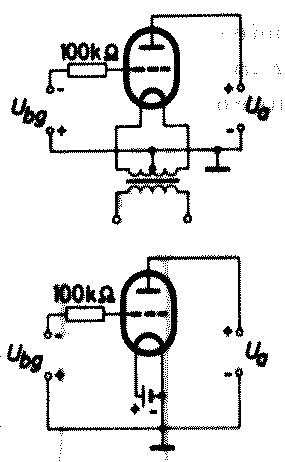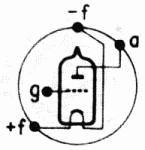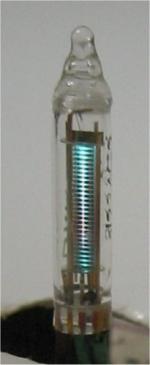
DM160
|
|
|||||||||||||||||||||||||||||||||
|
Hits: 22699 Replies: 4
No Plate
|
|
|
Joe Sousa
31.Oct.09 |
1
The DM160 indicator triode has no plate as such; instead it has a spiral grid coated with fluorescent material that glows when hit by the electron stream. The construction can be though of that of tetrode, with a missing plate. The second grid glows green and is the Anode of this triode. The back of the tube has a reflective plate to reflect the distributed glow of the grid, and serves as conductive support for the top of the filament. The red vertical streak is the filament. The gray toned grid that is visible in the second photo is the anode, and the the gray tone comes from the fluorescent coating.. The silver post to the right is the reflective metal tab that also serves as cathode terminal. The copper rod to the left is just a support The first photo shows both grid structures, with the gray tone anode surrounding the standard control grid. DM160 (click photo to enlarge)It is clear that there is green glow on the back side of the anode grid that faces away from the cathode. This means that electrons overshoot the second grid but are atracted back to make the grid glow green. The other side of the anode grid glow is seen by reflection from the polished back tab. The tube size is quite small at 1.1inchX0.2inch (28mmx5.5mm) This is about half the size of a typical subminiature tube.. These 1200dpi images were collected with an Epson 1200U scanner. The two images with the fluorescent glow were taken with the transparency/negative scanner back-light that iluminates from the side of the scanner lid. I used Google-Translate to read this German language post about using scanners to photograph tubes. Regards, -Joe |
|
Michael Watterson
01.Dec.11 |
2
The IV-15 is often sold as a DM160 equivalent. It's about 1/2 the price or less and is a similar kind of tube. But it's not the same, only similar. Diameter about 6.5mm and length about 24.5mm, the glow is a bit broader and shorter. On overall volume the DM160 is slightly smaller, but about 3mm longer including tip. The IV-15 filament volts is slightly lower (0.6V to 0.9V) with slightly higher current of about 35mA @ 0.6V At 20V HT the Anode currents for varied g is 0V, very dim, 24uA 0.6V dim, 95uA 5V, quite bright, 610uA. The brightness is usable at 10V HT (400uA) and 35mA @ 0.6V filament with g= 5V While LEDs were discovered in about 1906 and 1924, they were commercialised from about 1962. The DM160 was released in 1959 and release date of the IV-15 is unknown. The advantages the DM160 and IV15 have though is "built in" triode, so can be an amplifier and quite high input impedance. Power consumption for equal brightness is though much lower* for the VFD even including filament which is why the multiplexed VFD seven segment displays in pocket calculators saw usage till the mid 1970s. Larger LED displays only used for desktop application as LCD became standard for pocket calculators and watches. Today the VFD technology pioneered in the DM160 is still used in POS, set-boxes, kitchen appliances and cars. Though the Anode design of modern VFD is more related to the DM70 (DM71) than DM160 See Also Vintage Indicators, DM70 , DM71 and IV-15 (* High Efficiency LEDs are much later, after LCD is common) |
|
Paul Reid
03.Dec.11 |
3
> LEDs ... were commercialised from about 1962. True; but they were very expensive until Monsanto and others hammered-out better devices and production techniques in the late 1960s, and volume ramped-up in the early 1970s. LED calculators and watches came onto the market and prices fell fast. I recall the LED going fromnearly unknown in 1970 to under a dollar around 1972, to $0.15 in 1975. Pre-1970s, neons and ncandescent were the common technologies. Nixie tubes. VFD (1967) completed well in more elaborate displays such as VCRs where many digits and symbols could be "printed". Later advances in low-power LCDs drove-out LEDs and VFDs in battery systems (calculators, watches, PDAs) although VFD persisted where power was ample (lines-operated, cars) and "glitz" was desired.
|
|
Michael Watterson
03.Dec.11 |
4
Yes, I point out that VFD far more popular in Pocket Calculators in the early to mid 1970s. By the time LEDs were bigger and cheaper and brighter (about 10 years), LCD was main technology for pocket/wrist/battery devices. The only long term niche in the home has been in Mains powered Clock Radios. Still sold today. Some coffee makers. VFD are more popular on Microwaves and Ovens than LED. Far more POS, Setbox, DVD/BD player etc use VFD to day than LED as it's more customisable. Successors to DM160
Each segment is an Anode, many in parallel. Areas or groups of segments are covered by mesh grids. Multiple Cathode (Direct Filament) in the forground. Not many people know that the 1st LED and 1st 7 segment based VFD (one tube per digit) came out pretty much at the same time. It took 10 years for LED to "catch up" as numeric display. You would have thought LCD and LED would have replaced VFD. But brand new cars are using VFD because unlike LCD it doesn't freeze or be destroyed by heat and it's similar power consumption to bright LED but a LOT more customisable. Maybe some day larger AMOED or even LED matrix display will be possible. But today the VFD is larger and longer life and cheaper than AMOLED.
Chip on Glass is available too with identical electical and software commands to LCD, even as colour graphic modules (but not same principle as Plasma TV as those use gas discharge, all VFD are vacuum triodes).
|
|
Michael Watterson
05.Dec.11 |
5
I don't have DM160, but I do have all the other devices in the photo, so I edited in a DM160 at the correct size.
From Left to Right 1/2 size Neon, DM160 (VFD Triode), Russian iv15 (VFD Triode), Russian 1j24b Pentode (13mA), Western CK5768 Pentode (50mA), DM70 Magic Eye (25mA) Mullard DL94 Pentode/Beam Tetrode (50mA x 2) B7G family (Earliest perhaps RCA IT4 in 1939) Only the neon has no filament as all the others are Vacuum, the sub-miniature (smallest size) neon is included for size comparison. The DM160 is slightly longer "nipple" / taper but a bit narrower, so less volume. It must be the World's smallest Triode? Later gain as triode of the DM160 and iv15 will be compared. The DM70/DM71 while the World's smallest Magic Eye is a poor triode and obviously much larger than the Russian High performance Rod Pentodes or the Western (RCA originated as proximity Fuses in WWII) sub-miniature Pentodes used in early 1950s in Hearing Aids and almost to the 1970s in manpack Military sets.
|
End of forum contributions about this tube
| Data Compliance | More Information |












